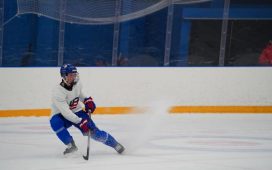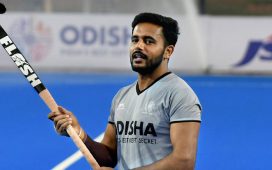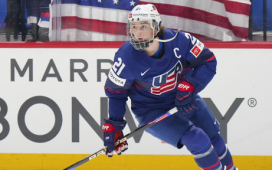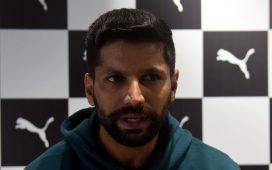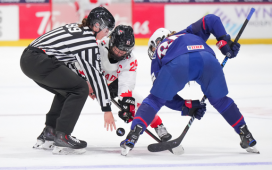Earlier this week, The Hockey News caught up with Jayna Hefford, Hall of Famer, four-time Olympic gold medallist and current Professional Women’s Hockey Players Association head/operations consultant. The discussion topics included her transition from playing to leadership, the Dream Gap Tour, the quest for one major women’s pro league and the PWHPA’s relationship with the NWHL.
THE HOCKEY NEWS: Dating back to your Hall of Fame playing career, when you were competing in Olympics and enjoying your prime years, did you always get a sense that you would eventually end up in a leadership role? Or is that something that came to be later, when you were closer to retirement or after retirement?
JAYNA HEFFORD: It definitely evolved. I always knew and felt like I wanted to stay in the game. I really didn’t know how, to be quite honest, or how that would evolve. After I retired, and actually my last few years of playing, I was doing some part-time coaching. I’ve run my own hockey camp – this would have been our 24th year. Obviously it got cancelled this year. So then [I did] a lot of teaching. And then I did some coaching with the University of Toronto after I retired. I spent a full year coaching there before taking on the CWHL (as interim commissioner), so I really tried to get my hands dirty in a lot of different roles.
It’s always interesting: when you’re a player, you don’t understand half of what goes into coaching. And then you coach, and you don’t understand half of what goes into the administration and the leadership positions. So I’m really happy that I’ve had a chance to get my hands dirty in all of these roles at this point. But I do really enjoy the business side of the game and certainly feel challenged in that right now. I always knew I’d be in the game somehow, but it definitely has evolved in a fairly organic way.
THN: What specifically made you decide to take on your current leadership role with the PWHPA?
HEFFORD: When I took on The CWHL role, it all happened pretty quickly. I always felt like that was an opportunity to really make it better for the players, and that’s honestly why I wanted to get involved. In the course of my career, I played in three professional leagues, and I wanted to find a way to bring more visibility to them and put the game in a better light with more exposure – all those things I felt like the game really needed because the game itself was so good. So when the league folded, it was so disappointing, but I feel optimistic that it was opening the door for change to happen.
I was away from the game for a bit. It wasn’t until August 2019, so not even a year now, when I had a text from Kendall Coyne and Billie Jean King’s organization, and they said, “Hey, can we chat?” and instantly said, “We want you to take on this role.” They had hired someone, it wasn’t working out, and my only real question was, “Is this something that the players want?” And they said, “Yes, the players want you to take on this role and sort of be the lead on this.” And that was really enough for me to know that the players wanted me to do this. But I look at this the same way as the CWHL in terms of, I want to find a way to put the game in a better place. I think over the course of my time in the CWHL, the players saw the way we were putting the game out there, and we had some television contracts we didn’t have (before), we had some great events, and we had some people supporting the game that hadn’t before.
THN: Before we get into the PWHPA’s five-hub-city plan for play in 2020-21, can we clarify: is it still going to be branded ‘The Dream Gap Tour’ for next season, or does it not have an official name?
HEFFORD: We haven’t announced anything. We look at it right now as, it’ll be Dream Gap Tour part 2 or version 2.0. I don’t know what the name is going to be, but ultimately something similar.
THN: Can you outline why the PWHPA decided to go with the more centralized plan with the five hub cities for 2021? What are the primary benefits? And of course, as always, this question assumes that world health officials deem it safe to play in 2020-21.
HEFFORD: Ultimately, because we’re a players association and not a league, it’s very important how our membership feels and what their feedback is, so we did a survey at the end of last season. We had about 175 players, put out a survey to them, and it was really fairly simple, but it was just open-ended questions around what could make their experience better, what would increase their level of commitment, what they would like to see happen next season. We had responses from almost 140 players, so we had a really good response rate, really good representation from across our eight regions.
There were a few consistent messages, and they were around the commitment of everyone in the group. So their commitment would be better if others were more committed. It was around a greater competition. It was around trying to provide the most professional experiences and resources. Through all this feedback, we took that, and we said, “How do we grow this, how do we be better, how do we find ways to make it a better experience for the players?” What we decided to do was condense our regions to five so that we can provide more resources within those five regions. We want to be able to provide access to more ice. We want to be able to provide strength and conditioning facilities, and we want to be able to provide as much as we can, [including] medical therapy, all the things you can consider being part of professional environments.
[I’m] not saying that we’re going to be able to do all those things, but our goal is to provide a really professional environment in those five cities. Through that, it doesn’t say that somebody who lived in (previous PWHPA hub regions) Buffalo or Tri-state, they’re not a part of this. It simply means they become an out-of-region player, and they may not be consistently with a group, but they are still welcome to be a part of the PA and will still have the opportunity to be a part of one of these groups.
THN: Would it be accurate to say that improving the quality of resources for players is tied to the long-term goal of maximizing the product for the sake of advertising it? Advertising in this context meaning showcasing the game in the quest for funding, for an investor in a new league. Is that a possible endgame?
HEFFORD: I think our only motivation for making these changes and trying to improve the conditions is because we’re a players association. We want to provide the best experience, resources, professionalism for these athletes, as we didn’t pay anybody. None of these women get paid to play, so what we’re trying to fight for here is a professional league that provides those resources and the infrastructure that most professional athletes take for granted. You know – having someone to sharpen their skates or having tape on the table outside the dressing room. There’s a lot of little things that build up to be big things. Ultimately, we’re trying to improve the experience.
When you talk about investors and the NHL and different things, we don’t know what the NHL’s plan is. We do know that they’re invested in the women’s game. We’ve seen that over the last few All-Star Games, and I think history shows us that the only women’s professional leagues that have survived over a significant period of time are those that are established with men’s leagues. Building the infrastructure or the resources from ground up is really challenging, and I’ve been through three leagues while I played, and you come with an influx of money, and you start building, and then eventually that runs out. So we do believe that we need to align with an established league, and then there’s got to be that infrastructure in place. And that’s part of the overall investment that needs to be made in the women’s game if we want to see it truly grow.
THN: To put you on the spot: Is the NHL the target investor? Is the goal to achieve, eventually, the equivalent of the WNBA in terms of getting that help from the most prominent of all the men’s leagues?
HEFFORD: That’s certainly our goal. We believe the best opportunity to succeed as a sport is to be aligned with the NHL in some way. When you look at the WNBA, has everything been smooth and perfect over their 25 years? Of course not. And NWSL, who aligns with MLS but also with U.S. soccer and Canada soccer and Mexico soccer…are any of those models perfect? Maybe not, but we do believe that our best chance to succeed would be to align with the NHL simply because of their experience, their infrastructure and the resources that are already in place.
THN: The PWHPA’s 3-on-3 showcase at the 2020 NHL All-Star Game was tremendously entertaining. Is there a plan to repeat the same event next year – or do something on a larger scale? Have you discussed or started planning anything like that? A showcase that’s separate from Dream Gap and would be appearing on national TV with a massive audience?
HEFFORD: Unfortunately, we don’t know a lot of that right now. We felt like we had a lot of really good momentum before COVID hit. That certainly has paused momentum and made it difficult for a lot of NHL clubs and teams that we were hoping to do some stuff with. When it comes to the All-Star event, that simply is an NHL strategy, and we haven’t had discussions around that for next season.
As to your point, the last two years, the women’s involvement in the NHL All-Star Game has been a highlight of the week, and I had a chance to be at both. That certainly was what everyone was talking about. We’d love to see that again, not necessarily the same thing but something like that, but that’s simply up to the NHL how they choose to implement the women. But it’s so important to be able to have the women on that platform, and I’m sure you’ve probably heard people say, there’s a lot of people that never saw women’s hockey until that time. So we continually are trying to source out ways that we can get on broadcasts, that we can be on a platform where people can see the game.
We had a chance to have four of our players play in the ECHL All-Star Game last year, and I thought that was a huge step, and credit to the ECHL for coming to us and saying they wanted to do something. The women actually played in the game with the men, and it was a great event. We’ll continue to look for opportunities like that. But right now, the planning process is pretty challenging.
THN: It’s no secret that there is tension right now between the PWHPA and the NWHL. We’ve seen it on various social media posts, and it’s something people discuss. So, for the layperson who doesn’t really know exactly what’s going on, could you share what the sources of tension are? Does the PWPHA believe the NWHL is not pushing the game forward for women?
HEFFORD: I wouldn’t say that. I wouldn’t say they’re not pushing the game forward. I would say some of the sources of tension are external. We have incredibly passionate women’s hockey fans. So a lot of that tension I see comes out on social media. I think there’s a narrative in women’s hockey, and to be quite honest, I don’t know if it’s in other women’s sports, but it certainly isn’t in men’s sports – that it’s one league or the other.
We talked about the landscape of men’s hockey in North America and how many professional leagues are there. And when we look at that, we look at the NHL. The NHL has all the best players, I think that’s something everyone could agree on. But once you get beyond that, there’s a number of different leagues, and they provide opportunities for guys to develop and train and hopefully still have a chance to make the NHL. So can we coexist? Absolutely. If there’s a women’s pro league, it’s probably going to have 120 to 125 players in it. So, are there more than that who are going to be supported at a professional level? Of course there are.
So, I don’t think the NWHL is hurting the sport. But our visions are very different. For us to succeed, we don’t think building from the ground up is the right way to go. We’ve been there, we’ve done that. We’ve been through different private investor models to not-for-profit models. We need to start with the infrastructure, start with the resources, have that foundation in place in order to truly grow, and the investment that needs to be made is big. That’s why I don’t sit here and say, “The NHL, why don’t they do it? They should just do it tomorrow.” This is a big investment that has to be made.
We all understand that, but we all also believe there are good business reasons to do this. At the end of the day, we [and the NWHL] have very different visions for the future of the game and how we get there – maybe not even future, but certainly how we get there. Currently, we represent all the top players in the world, and we are pushing for something truly professional that all would consider professional. I think the [NWHL] individuals, from what I’ve heard and what I’ve read, believe it’s OK to stand alone and to build from the ground up and take small steps along the way, so I think we just have different visions. The tension, I think, is exasperated certainly through social media, but I believe we can coexist.
THN: As a woman and member of the LGBTQ community, you’re part of two demographics that have been marginalized historically in sports. Does that make the racism in the world right now hit home especially strongly for you?
HEFFORD: It’s difficult because there are a lot of biases around a lot a lot of things, whether it’s gender, whether it’s where you choose to worship, whether it’s ability/disability, whether it’s orientation or whether it’s race. Race is at the forefront right now, and I certainly could not imagine that sort of anger and fear and sadness and being a part of that community. I don’t want to pretend to understand that. But I think that change is happening – I guess I hope change is happening. I think people are not OK now, but we have to also be proactive and turn that into actions.
So it’s been really heartbreaking to watch. It’s devastating to see how divided we are and how broken society is. I hope it’s going to signal some change, and certainly there’s a lot of talk around change, but it’s got to be followed up by action. I know, personally, I am going to commit to try to make sure I’m learning and educating on, “How we can help our players, and how do we educate our players better?” There have already been those discussions, so I hope that we can be part of the change.
Want more in-depth features, analysis and opinions delivered right to your mailbox? Subscribe to The Hockey News magazine.




